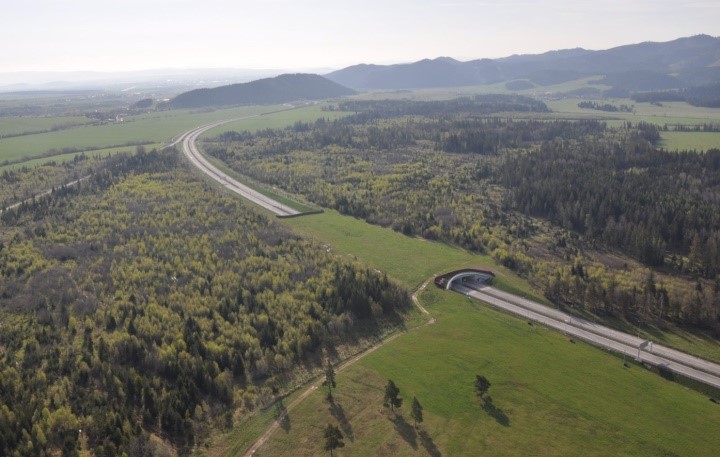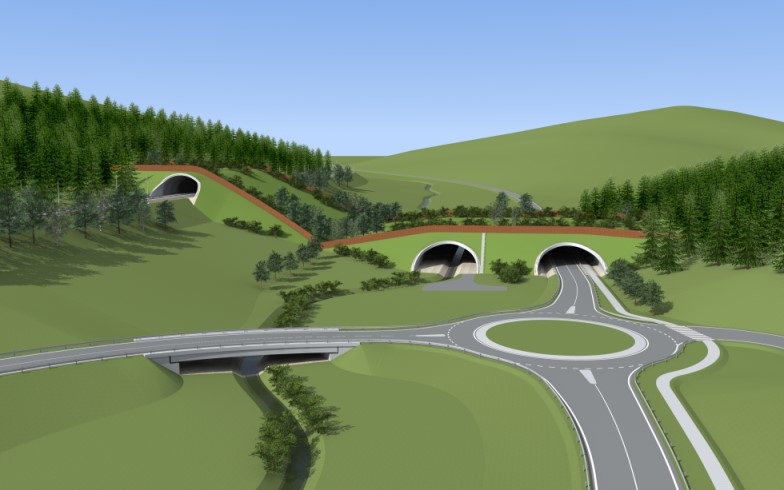ConnectGREEN - Which animals are using Slovakia's green bridges?
16-02-2021
At the end of last year, the Slovak National Motorway Company (NDS) launched a public tender for the construction of a green bridge in Svrčinovec, Kysuce. It will be the fourth ecoduct built by the NDS in Slovakia. Where are the others and which animals use them? And how have the projects such as TRANSGREEN or ConnectGREEN helped to design them?
Moravský Svätý Ján ecoduct: deer and roe deer
The Ecoduct at Moravský Svätý Ján in southwestern Slovakia on the D2 motorway was built by the NDS in 2016, and the location and form reflected the results of the international project of the Alpine-Carpathian biocorridor supported by the European Union. During 2019, cameras captured 476 unique animal records and 101 unique human records on this ecoduct. People are not welcome visitors here - they disturb animals and reduce the effectiveness of the green bridge.
"Since we also have data for the year 2018, we can compare those years. The largest activity of animals was captured on the ecoduct in the spring months, especially in April. From the species point of view - roe deer (Capreolus capreolus) were dominating the ecoductin both years, which is related to the fact that the ecoduct is located in an area, where deer are abundant. Deer (Cervus elaphus) visited the ecoduct in 2019 up to a third more often (percentage) than in the previous year," says Eva Žgravčáková from the National Motorway Company. Wild boar were also numerous.
The ecoduct is beginning to resemble the surrounding landscape, grass, bushes and trees are growing on it, therefore is still growing more attractive for species such as the red fox or the badger, or the marten or the weasel. The fact that the ecoduct is no longer new to the animals is recognisable from their behaviour when crossing it. "While last year and in early 2019 animals behaved cautiously, sometimes uncomfortably, on the body of the ecoduct, during the summer and autumn of 2019, when the ecoduct began to overgrow with taller grasses and shrubs, their behaviour since calmed down and they spent more time on it. In the case of roe deer, the cameras also recorded grazing directly on the ecoduct,” explains Žgravčáková.
The transition of large carnivores such as bears, lynx or wolves has not yet been detected on the ecoduct. The territory is not one in which they commonly occur. Nevertheless, in September 2012, a young bear was seen about a kilometer from the site of the future ecoduct, and in the summer of 2019, observations of a bear with a cub near the ecoduct were reported.

Image 1: When the ecoduct begins to overgrow with grasses and shrubs, animals spend more time on it. © NDS
Ecoducts under the Tatras: one busy, the other not
The first ecoduct in Slovakia is “Lučivná” on the D1 motorway Važec - Mengusovce, built in 2009, and the second a bridge on the D1 Mengusovce - Jánovce. The NDS footage from the cameras confirms that “Lučivná” is used by various species - wild boars, roe deer or deer, or even large carnivores - wolves and bears. The ecoduct is reminiscent of the surrounding landscape, so grazing deer or does are not uncommon, the cameras even recorded a fascinating match between two deer on the body of ecoduct itself.
Even the bear called Iwo used “Lučivna” while wandering across Slovakia. During his long search for a partner, in May 2015, he migrated 373 km from Poland through the Slovak High Tatras to the Hungarian Aggtelek National Park. On the way he crossed roads, railways, the river Váh and highway D1 through the Lučivná ecoduct.
The bridge on the section D1 Mengusovce – Jánovce on the other hand is not very popular among animals. No wonder: An efficient green bridge must not only be built along a migration route, but must be wide enough and must simulate vegetation and environmental factors such as soil type, humidity or light. This bridge is only about 12 meters wide and has an asphalt surface. "Colleagues from the Polish side of the Tatras have a record of a wolf, tracked by a telemetry collar, who came to this ecoduct, but turned around and did not use it," says Erika Feriancova of the TANAP Administration. In comparison - the Mengusovce ecoduct is about 250 metres wide.

Image 2: Ecoduct Lučivná under the Tatras © NDS
Ecoduct Svrčinovec: bear, wolf, lynx
In order to maintain the connectivity of the protected areas Kysuce (SK) and Beskydy (CZ), the construction of the ecoduct was a condition for the non-refundable contribution for the construction of this part of the motorway by the European Commission. The ecoduct must be built until 2023. When the construction is complete, the green bridge will consist of two parts - one will cross the road I / 11 and the other the railway. It will be 80 m wide.
The process of choosing the location for the bridge’s construction was preceded by extensive monitoring, already during the international TRANSGREEN project, which was succeeded by the ConnectGREEN and SaveGREEN projects. While the first already completed project, TRANSGREEN, focused on identifying places where animal migration routes collide with the transport infrastructure, the ongoing ConnectGREEN project maps critical places not only on roads or railways, but also barriers in the open countryside, especially different types of buildings or fencing. The SaveGREEN project builds on both projects in order to maintain the functionality of these animal migration routes.
Monitoring in the Kysuce Protected Landscape Area and the Beskydy Protected Landscape Area confirmed that Svrčinovec is a functional migration corridor used by animals. On this traditional route, the customs construction site at the Slovak-Czech state border was built in the 1990s. The movement of wild boar, roe deer and deer was recorded on the corridor as well as signs of otters, badgers and hares. And, of course, long-term monitoring confirms the presence of large carnivores in the area. "The Kysuce Protected Landscape Area Administration has been monitoring the migration corridor of supra-regional significance for a long time and throughout the year, and information from the field confirmed the occurrence and dispersion of all three large carnivores, bear, lynx and wolf in the area," says Peter Drengubiak from the Kysuce Protected Landscape Area Administration.

Image 3: Ecoduct Svrčinovec © NDS
Ekodukt Mýtna - Lovinobaňa, Tomášovce: wolves and bears
NDS estimates that another ecoduct should be built near the village of Tomášovce (South-East Slovakia). This section of the R2 expressway is currently under construction. It is a migration corridor between the Alpine and Pannonian bioregions - from Poľana, Veporské vrchy or Muránská planina, animals moved through the Lučensko-Košická depression to the Procected Landscape Area Cerova vrchovina and from there further to the northern Hungarian Central Mountains, e.g. also to the Bükk National Park.
Monitoring and experience of state conservationists confirm that the corridor is used by deer, roe deer and wild boar. Among the animals that often pay with their lives in the attempt to cross the road are red foxes, martens and otters, but the deaths of deer, roe deer and wild boar have also been recorded. Moreover, the existence of a wolf in the area of the biocorridor has also been confirmed. Repeated reminders demonstrate the need for safe crossing opportunities: in the wider area of the section R2 Mýtna – Lovinobaňa, authorities recorded the death of a wolf in April 2018 as well as the death of a bear in November of the same year. Overall, this part of the country is not yet as densely built up as Kysuce. Nevertheless, migration routes are threatened by the uncontrolled construction of fences.
In another section of the R2, a viaduct is planned to be built, which will allow animals to migrate under the road. Csaba Balázs from the Cerová vrchovina Protected Landscape Area Administration says that, thanks in large part to the outputs of the ConnectGREEN project, the region now has the opportunity to plan for the protection of an entire system of migratory corridors for animals in adequate density so that it can be truly functional "and animal populations on either side are not cut off from other populations. Construction (including linear structures) is a significant factor causing isolation and subsequent deterioration of the population of individual species. The worst case scenario is the absence or extinction of species in a certain area, which results in an overall decline in the region's biodiversity."
